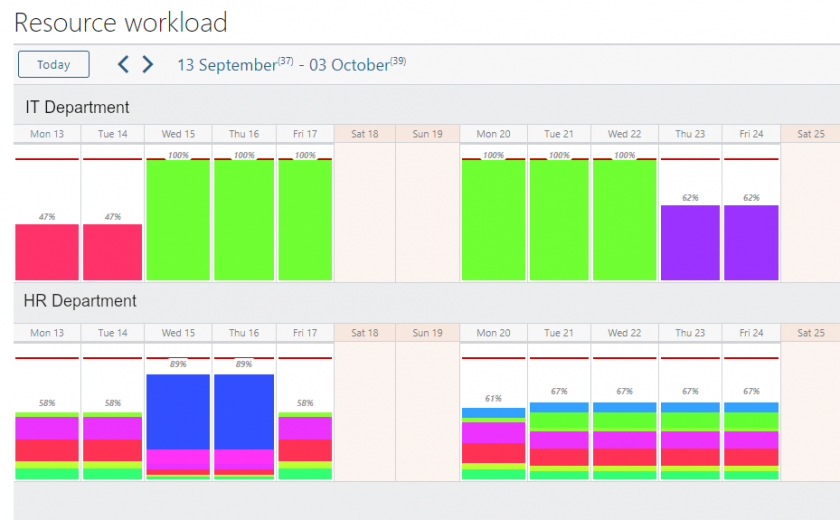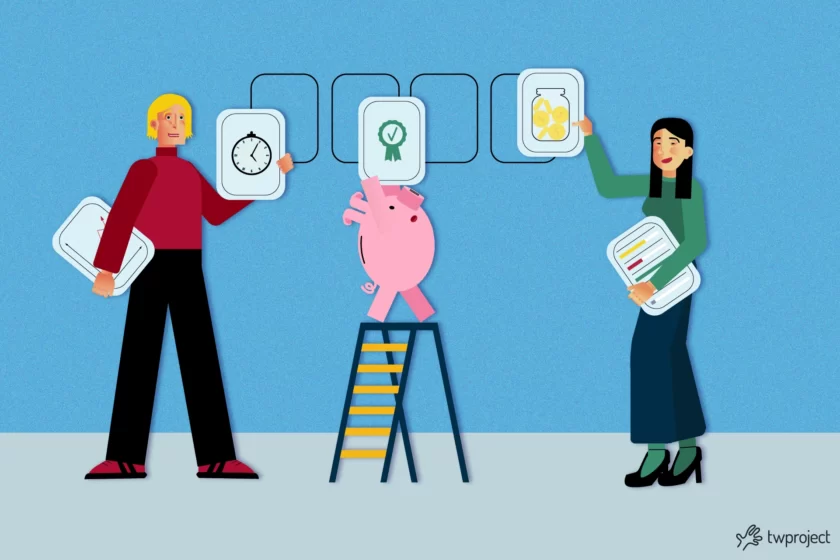In project management, knowing how to gauge project success is just as important as planning it correctly.
Project KPIs (Key Performance Indicators) are crucial tools for determining whether a team is heading in the right direction, whether resources are being utilized effectively, and whether project objectives are being effectively achieved.
CONTENT
- What are project KPIs?
- Why KPIs are crucial in project management
- Types of project KPIs
- How to choose the right project KPIs
- How to measure progress through time
- Measuring success: qualitative and quantitative KPIs
- Measuring success: qualitative and quantitative KPIs
- KPI and decision making: how to use them to guide your choices
- Best practices for effective use of KPIs
In other words, project KPIs help project managers track results, compare data with expectations, and make fact-based decisions rather than relying on gut feelings. Let’s take a look at what they are, how to choose them, and which key performance indicators to adopt to improve the effectiveness of your projects.
What are project KPIs?
Key performance indicators are metrics that measure the performance of a process, a team, or an entire project. In project management, KPIs are used to track work progress, evaluate resource efficiency, and understand whether set goals are actually being met.
Every project KPI must be:
- Relevant: Related to the strategic project goals.
- Measurable: Based on objective, numerical data.
- Timely: Regularly updated to provide helpful information.
- Comprehensible: Clear to all team members.
A KPI must be useful for measuring progress concretely and comparably over time. For example, a KPI could tell you the percentage of completion of a phase or the ratio between the budget spent and the planned budget.
Why KPIs are crucial in project management
Project KPIs are not just numbers, but actual strategic assets. They help you effectively understand how well a project is meeting its expected timelines, costs, and quality.
When managing multiple projects simultaneously—especially with dispersed teams—keeping everything under control can be challenging. Project management KPIs help you visualize data in real time and take swift action if something goes off track.
For instance, a project manager can utilize software such as Twproject to create custom dashboards that display progress toward project completion, budget deviations, and team performance. This allows you to make informed decisions and act quickly to ensure project success.
Types of project KPIs
There are different types of key performance indicators. Not all of them serve the same purpose: some gauge productivity, others measure quality, and still others assess customer satisfaction or financial sustainability. Let’s take a look at the main categories.
1. Time performance KPIs
These KPIs measure how punctually a project progresses compared to the initial plan.
Examples:
- Schedule Variance (SV): Indicates whether the project is ahead of or behind schedule.
- On-time Completion Rate: Percentage of tasks completed within the due date.
With a tool like Twproject, you can easily keep track of this data thanks to interactive Gantt charts and automatic reports.
2. Cost KPIs
They measure how well the budget is being honored. Among the most common are:
- Cost Performance Index (CPI): Measures the ratio between earned value and actual costs.
- Budget Variance: The difference between the planned budget and the actual budget.
A KPI must be aligned with the project’s financial expectations: if the CPI falls below 1, it means you’re spending more than you’re producing.
2. Cost KPIs
- Schedule Variance (SV): indica se il progetto è in anticipo o in ritardo rispetto alla pianificazione.
- On-time Completion Rate: percentuale di attività completate entro la scadenza.
Con un tool come Twproject puoi tenere traccia facilmente di questi dati grazie ai diagrammi di Gantt interattivi e ai report automatici.
3. Quality KPIs
Quality is not limited to the final product but also concerns processes and schedules.
Some examples are:
- Percentage of errors or defects detected.
- Number of revisions required to complete a task.
Measuring this data provides valuable insights for optimizing workflows and improving internal procedures.
4. Resource and productivity KPIs
These key performance indicators help you understand whether your team is efficient.
Some examples are:
- Resource utilization rate.
- Average productivity per team member.
- Actual working hours vs. planned hours.
With Twproject, you can see who is working on what in real time, thus avoiding overloads and improving workload distribution.

How to choose the right project KPIs
Not all KPIs are suitable for every scenario. The choice should depend on the nature of the project, the industry, and the project’s goals.
Here are some best practices for picking the most effective ones:
- Align KPIs with your strategic goals. If you’re trying to shorten delivery times, measure lead time and average task duration, not just productivity
- Involve your team in the definition. Every member must understand the meaning of KPIs; otherwise, they become just numbers to fill in.
- Choose a few but meaningful KPIs. Measuring too many things can be distracting. It is better to have a few well-targeted indicators that can be effectively monitored.
- Update and review KPIs periodically. Projects evolve, and KPIs must also adapt to change.
A KPI must be dynamic: if an indicator does not provide helpful information, it is better to replace it.
How to measure progress through time
Setting KPIs is just the first step: the real challenge is measuring progress and interpreting it correctly.
Constant monitoring helps you understand whether the project is progressing towards its set goals or whether action needs to be taken.
With tools such as Twproject, you can set up automatic alerts that flag unusual variations in costs, times, or productivity.
For example, if a task is 20% over schedule, the system can provide real-time information to the project manager, allowing them to take prompt action to correct the course.
This ability to react is what differentiates a failed project from a lasting project success.
Measuring success: qualitative and quantitative KPIs
Not all KPIs are expressed in numbers. Some areas of project management, such as internal communication or collaboration, are measured using qualitative indicators.
Here are the two main categories:
- Quantitative KPIs: measure objective data such as costs, time, or productivity.
- Qualitative KPIs: evaluate perception, satisfaction, or quality of work.
Both can be combined to offer a complete overview. For example, you can measure success not only by looking at profit, but also at team satisfaction or the quality of communication. An effective way to balance these aspects is to create integrated dashboards where numerical data coexist with subjective assessments.
KPI and decision making: how to use them to guide your choices
A KPI must be not only descriptive but also predictive. It helps provide information that is useful for making better decisions.
Key performance indicators help identify trends and patterns that can anticipate problems or opportunities.
For example, a steady decline in productivity may point to work overloads or motivational gaps within your team.
The best project managers use KPIs as project-intelligence tools, capable of suggesting corrective actions before issues become critical.
Integrating KPIs into the project lifecycle
Project KPIs should not be considered static elements, but rather an integral part of the project lifecycle.
- During planning, define your project objectives and related KPIs.
- During execution, collect data to track progress toward goals.
- During monitoring, analyze your results to check whether you have achieved your goals.
- Upon completion, evaluate your final KPIs to measure overall success and lessons learned.
This continued integration transforms KPIs into a powerful organizational learning tool.
Practical examples of project KPIs
Here are some practical examples of project KPIs that can be used in most scenarios:
| Area | KPI | Objective |
| Tempo | On-Time Completion Rate | Ensure timely deliveries |
| Costo | Cost Performance Index (CPI) | Check financial sustainability |
| Qualità | Defect Density | Minimize errors in deliverables |
| Risorse | Team Utilization Rate | Evaluate operational efficiency |
| Soddisfazione | Customer Satisfaction Score | Improve customer perception |
Every KPI must be tied to a clear and measurable objective to provide useful information and guide future decisions.
Best practices for effective use of KPIs
To recap, here are some best practices for using project KPIs as effectively as possible:
- Set clear goals. A KPI without a purpose is meaningless.
- Collect accurate and up-to-date data. Without quality data, KPIs lose their value.
- Communicate results. Share dashboards with your team: transparency boosts motivation.
- Analyze deviations. When a KPI varies, always ask yourself “why?”
- Link KPIs to business strategy. Every number must have a measurable impact on set goals.
With management platforms like Twproject, you can build a flexible, visual KPI system that enables you to track data and manage project success in real-time.
Ultimately, project KPIs are more than just a set of numbers; they serve as the guiding light that directs your project manager toward achieving goals and driving continuous improvement.
A KPI must be clear, relevant, and aligned with your strategy. Only in this way can it provide useful information for making decisions and keeping projects under control.
By following the best practices described and using digital tools like Twproject to measure progress, every team can turn key performance indicators into a true competitive advantage.
All told, learning how to read and utilize project management KPIs in the most effective way possible is key to ensuring your project succeeds and that every business effort yields real, measurable results over time.




